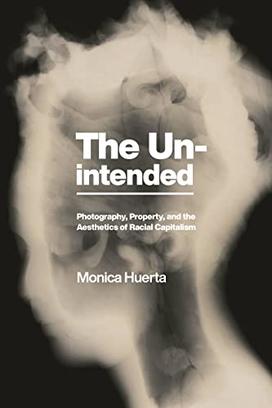Monica Huerta *06 Highlights the Legal Consequences of Photography in Latest Book
The book: In her latest book, Monica Huerta *06 tracks the intersection of photography and property law in the 19th century and its legal impact. The Unintended (NYU Press) ultimately highlights the subtle and paradoxical ways legal thinking through photographic lenses reinforces a particular aesthetic of whiteness when it comes to property ownership. Through this unique analysis, Huerta argues that studying photography in relation to property rights further proves the function of white supremacy in U.S. culture and impacts our lives. 
The author: Monica Huerta *06 is an assistant professor of English and American studies at Princeton University. Her research and teaching center critical race and ethnicity approaches to literature and culture, especially visual culture, photography, and legal studies. Magical Habits is Huerta’s first book and a recipient of the Duke University Press Scholars of Color First Book Award. She has a Ph.D. in English from the University of California, Berkeley, an M.A. in history from Princeton, and a B.A. in history and literature from Harvard University.
Excerpt:
Introduction - Without Intention
Studies of racial capitalism can help us ask questions about the adjudication of property rights in photographs. More often, to study photography, critics and historians tend to follow a variety of techniques attempting to marshal light, chemistry, and mechanism; imperial modes of staging, thievery, and surveillance; inventors and masters; embodied practices; minor keys of fugitivity; the epistemes that taxonomized its movements and mechanisms; the industries that made use of its reproductions and modes of interpretation that learned to see and unsee at once. Yet each of these trajectories that become identifiable as photography or photographs intersects in some way with property rights. In every new imperial instantiation of a market, property-making was reimagined through operationalized dispossession and the speculation and figuration of extracted value, productive of and facilitated by the variable phenomenon of race. That is to say, the history of photography and the history of racial capitalism were ever conjoined. In particular, the legal paths of prints and reproductions, photographers and their subjects, reveal a proximity between commingled, unequal dispossessions and photography’s history as a medium of expression and form of commerce. Critics have made important interventions toward understanding photography as an implement for colonial regimes and photographic registers of imagining worlds to supersede racist and capitalist realism’s confines. Yet there is still room to understand further how lawyers, photographers, and subjects articulated photography’s harms and claims to art in property’s terms from inside the history of race.
I argue in this book that examining legal episodes in the late nineteenth and early twentieth centuries can illuminate the subtle pathways of racial capitalism’s reproduction through the ways whiteness makes use of the camera’s everyday aesthetic work, especially in performance practices, novel forms of commerce, and the circulation of reproductions. The ubiquity of new kinds of cameras helped transform a specific aesthetics of whiteness into a technique of power that hinged on the ability to delimit (which is to say, imagine a specific sense of) intention and its absence. The Unintended argues that it is this capacity—to authoritatively determine what qualifies as intention and how to figure its presence or absence—that can crystallize what’s elusive about whiteness even as its figurations make racial capitalism function: both abstraction and specific value, a governing universal that sets the terms of commercial engagement and the capacity to profit, and, for some, the potential for individuation: a capitalist aspiration made into a condition of being through an aesthetics of whiteness.
By an “aesthetics of whiteness,” I mean a set of procedures expressed wittingly and unwittingly by jurists and photographers alike to accomplish at least two things: (1) making whiteness visible as a material for study while it is also duplicated and presented for artful “appreciation” and adjudication while (2) nonetheless upholding the option of abstraction for whiteness, where profits can accrue to a holder because they exist as an abstracted system/structure outside a single person’s control. Whiteness portends to be a universal and thus act in the world as a neutral value, but it also can validate the utterly particular, such as an attribute of a photograph or the manner of a person’s pose. The stories I tell are part of what Hartman names “the ambiguous legacy of universalism” and “the exclusions constitutive of liberalism.” The key is that whiteness is a by-product of the production of the white male subject as the governing universal; that is, whiteness functioning as an aesthetics of power is a symptom of hegemony. It is necessarily capricious, shifting from universal to particular whenever convenient or expedient—whiteness as a universal that needn’t defend its universality as a value, and whiteness as a particular attribute valued for reasons stated both obliquely and directly. The workings of racial capitalism help produce and feed off that abstraction. Abstractions—in legal or economic terms— become the operation of power that allows whiteness to reproduce itself and oppression at once in a way that is central to the inner workings of circulation and value production of racial capitalism. The sense of an “aesthetics of whiteness” is produced in my case studies by a set of aesthetic judgments (to borrow Kant’s famous term) that are themselves part of a larger cultural logic specific to the nineteenth century. That logic takes the form of an unspoken set of scripts shared by artists, authors, photographers, lawyers, credit reporters, judges, actors, journalists, and advertising companies. Although not the central focus of this book, certain subjects resist by refusing to conform to the logic that a pose could be “legible” (and so viable) as an expression properly expressed (and so potentially owned)—or not. I approach these aesthetic codes with curiosity about their outsized effects, because the limitations and incoherences of whiteness instantiated as an aesthetics of power are not, with some study, hard to recognize.
Excerpted from The Unintended by Monica Huerta. Copyright © 2023 by NYU Press. Reprinted by permission of the author.
Reviews:
“When you look at a photograph, whose expression do you see? This is a question of perception, but it is also a question of property rights. The Unintended considers ‘stories about photography’s history as property’ and shows how much is at stake when someone claims to own an image. Expression gives way to possession, and matters of law, credit, identity, and aesthetics all hang in the balance. Monica Huerta seems to deliver a surprising analytic turn on every page. This book made my head spin.” — Caleb Smith, author of Thoreau’s Axe: Distraction and Discipline in American Culture
“Wholly original and exciting. Tracking photography’s intersection with property law in the late nineteenth century U.S., The Unintended evolves genuinely new possibilities for thinking about the medium’s role in the construction of race. Monica Huerta addresses the workings of capital in relation to the medium—not only photography’s status as a commercial practice, but also how it took up and redefined the ways bodies could be regarded as property. Closely historicized yet wide-ranging in its implications, Huerta’s book models a profoundly ethical attention to what the photographic archive can reveal.” — Dana Luciano, Rutgers University












No responses yet